COTTLE DENIM の魅力 / The Appeal of COTTLE Denim
2025.10.28
今回は、COTTLEのデニムについて記載したいと思います。
ブランドのオフィシャルページでは、Dictionaryとしてデニム製品について詳細に記載してありますので、以下よりご覧ください。
こちらのshop talkでは、僕自身が日頃から穿いている”C.T.L STRAIGHT DENIM PANTS”というものを通して、感じていることを記しています。
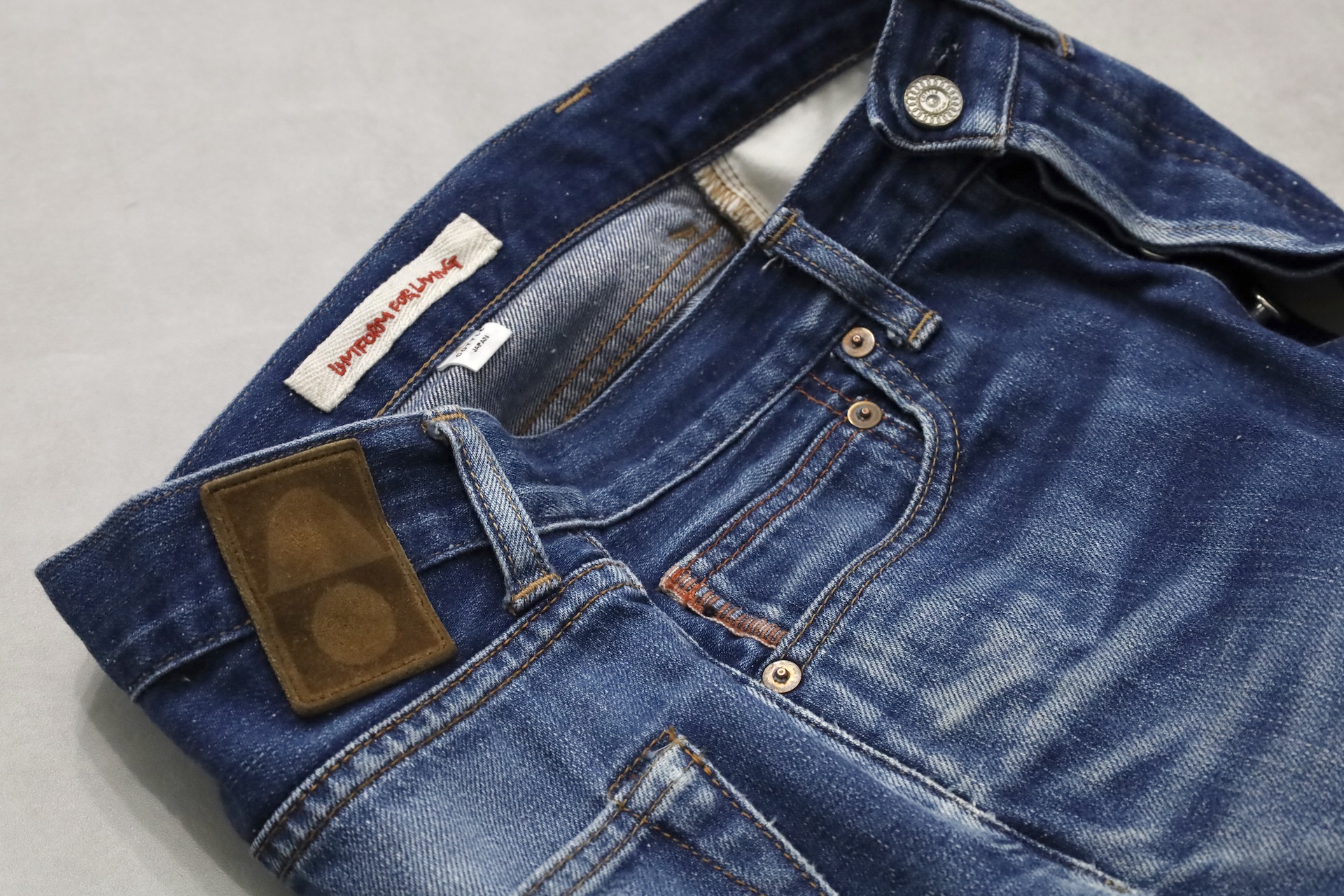
こちらの写真が大体3年半の期間、これまで僕自身がとてもよく穿いてきたもの。
COTTLEは、ジーンズの聖地と言われる岡山県倉敷市児島地域にアトリエを構え、デザイナーのキャリアとしても、これまで数々のデニム製品の製作も行なってきました。
ブランドが拠点を置く児島地域では、昔も今も、日々たくさんのデニム製品が製造されています。
また、先述の通り、デザイナーである渡辺さん自身も、これまでたくさんのものを製作してきた背景を持ちます。
COTTLEとして製作するにあたって、既に無数にジーンズが存在する中で、どのようなものであれば生み出す価値のあるものができるのか。ということを考え続け、デザイナーが様々な試行錯誤をしてきた上で完成しているのが”C.T.L STRAIGHT DENIM PANTS”です。
過去のものを否定するのではなく、先人たちに敬意を表し、”オーセンティックな5ポケットジーンズ”という枠組みの中で、生み出されたもの。
これに僕は魅力を感じ、とてもよく着用しています。
なぜ、このC.T.L STRAIGHT DENIM PANTSに魅力を感じているのか、自分が好きな理由は大きく分けて2つ。
1つ目は、先に記載したようにオーセンティックな5ポケットジーンズのディテールの範囲内でつくり上げていること。
2つ目は、そこにCOTTLEの明確なオリジナリティが注がれていること。
その2つの要素が非常に高いレベルで合致していることを感じています。
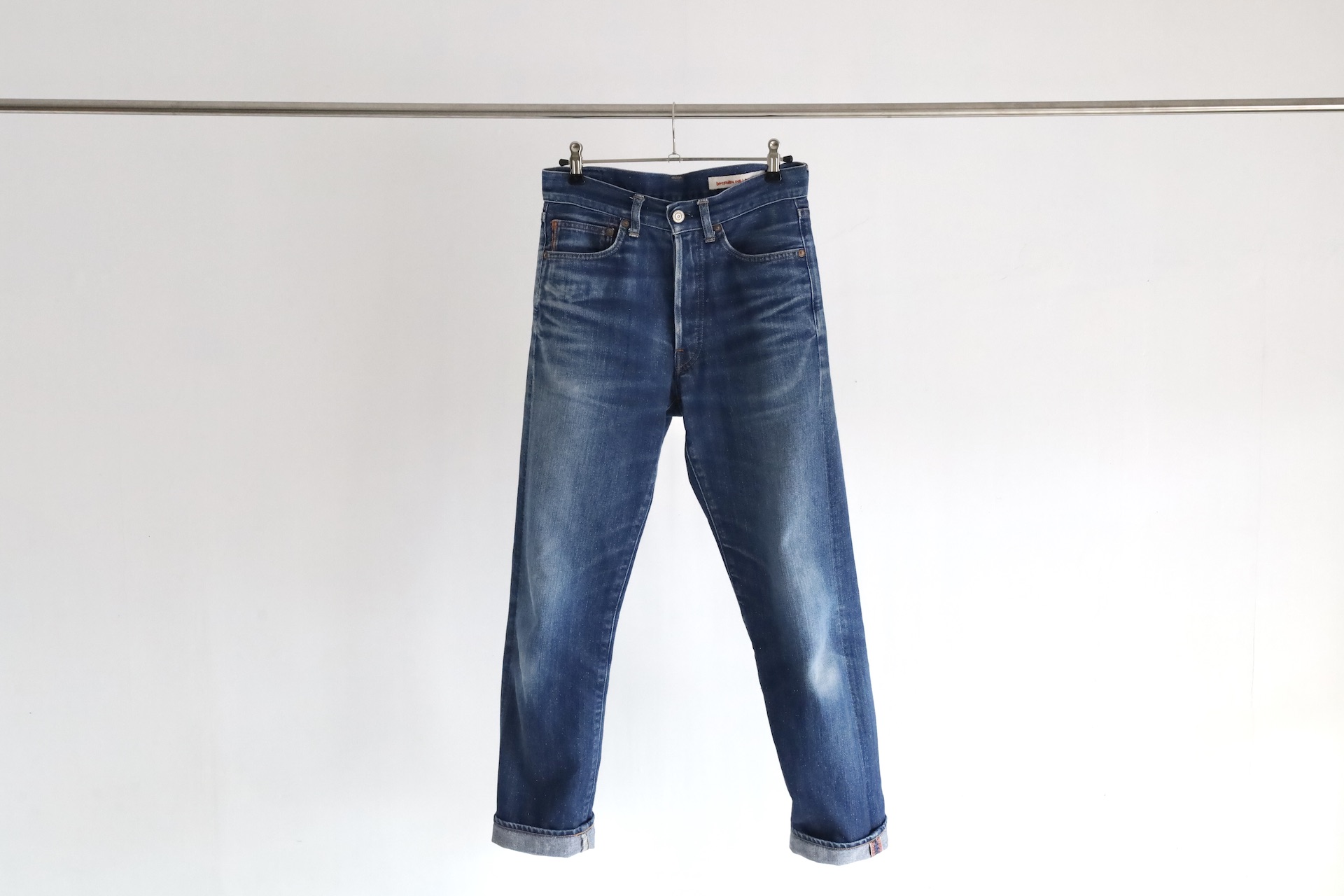

WASHED INDIGOというワンウォッシュ+ガス乾燥をかけられた状態から、使い続けているもの。
僕は小柄なので、サイズは0という最小サイズ。
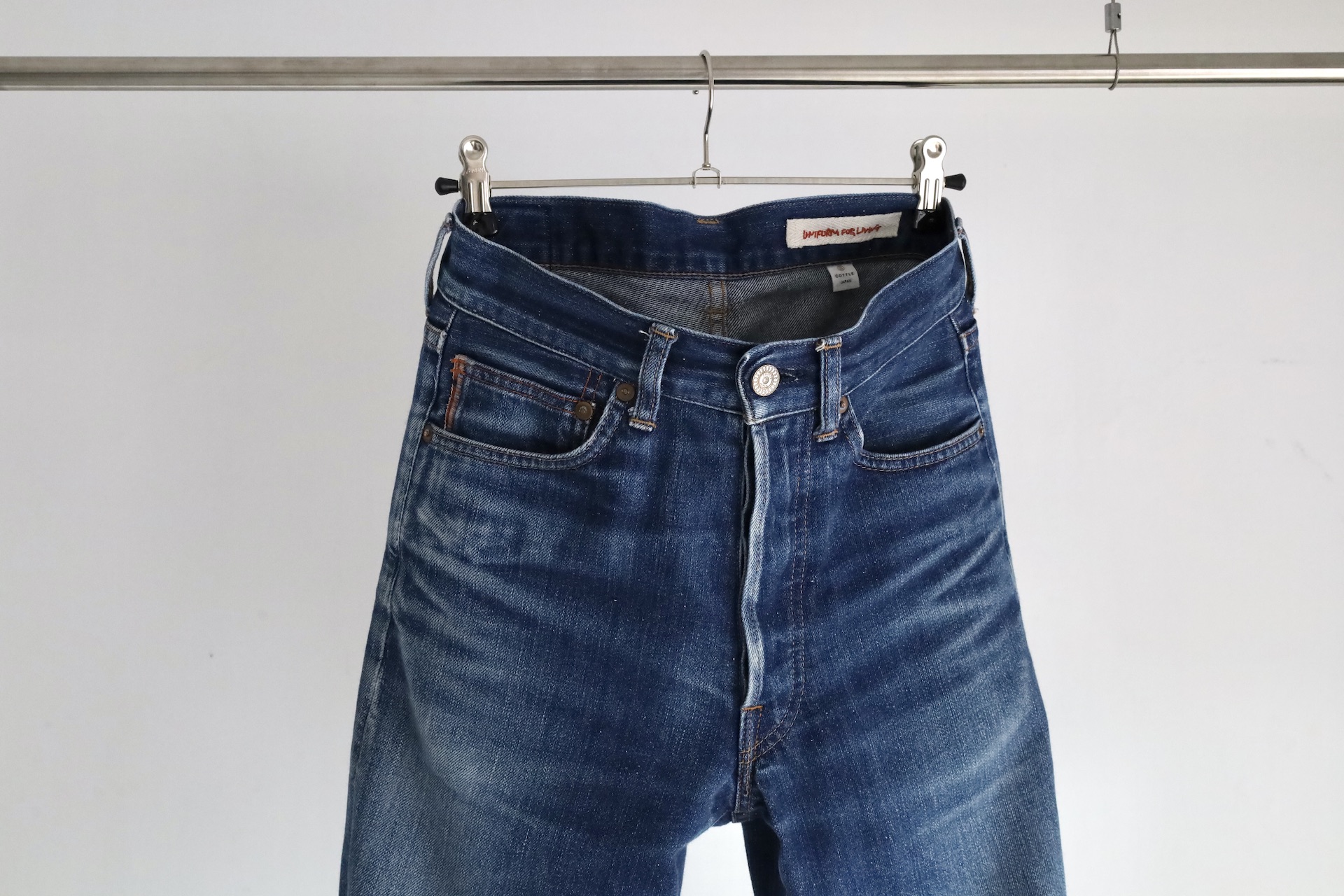
ワンウォッシュのものや、リジッドの場合には、自分の中ではベルトを必要としなくても穿けるウエストサイズで着用したいと思っています。
試着時にトップボタンを留めることができれば良いというサイズ選び。
そのため、写真を見るとウエストベルトには、座った時に生地が引っ張られた跡が残っていたり、ピッタリしたサイズで穿いていることによる通称”上りヒゲ”がついています。
ここで、1つ目のオーセンティックな5ポケットジーンズのディテールの範囲内でつくり上げていることについて紹介したいと思います。

この”オーセンティック”と言われるものは、一般的にその基準とされるのが、1947年に発売されたLEVI’S 501XX。
写真のウエスト周りだけでも、他のパンツ類とは異なる特徴的なディテールが数多く存在し、そのルールに則ったものが”オーセンティック”な5ポケットジーンズと言われる。
COTTLEのジーンズが、そこに準じている例をいくつか挙げて紹介します。
まず、縫製箇所によって、縫製糸の色使い、太さを変えていること。
COTTLEでは、1点のジーンズをつくるのに全部で”8種類”もの縫い糸を使用しています。
一着の洋服をつくる上で、箇所によって糸の色や番手を変えることは、他の種類のどの洋服と比較しても非常に特殊なのがジーンズという服です。
デニム製品を生産するには、本縫いミシン/オーバーロックミシン/インターロックミシン/環縫いミシン/巻きミシン/ベルトループ/カンドメミシン/ボタンホールミシン/タックボタン・リベット付けミシンなどなど、、、ミシンだけでもたくさんの種類の専用のものが必要となります。
また、洋服は、生地同色、もしくは、生地と近しい色合いの縫製糸で縫われることが基本とされます。
フランスで生まれた”デニム”生地が、アメリカのカリフォルニアで”ジーンズ”という服となって育まれたもの。
これが同じアメリカ内でも、もしニューヨークでジーンズが生まれていたら、きっとステッチは生地と同色になっていただろうし、このようなダブルステッチを基本とした配色ステッチは誕生していなかっただろうと言われており、その話に少しロマンを感じたことがあります。
製造現場においては、縫う箇所によって糸の色や種類を変えることは、その分コストがかかること。
かのリーバイスにおいても、時代と共に複数の色糸を使用することはなくなり、現代にジーンズを製作するメーカーでもCOTTLEほど多種の糸を使うことは、ほとんどなくなっていると思います。
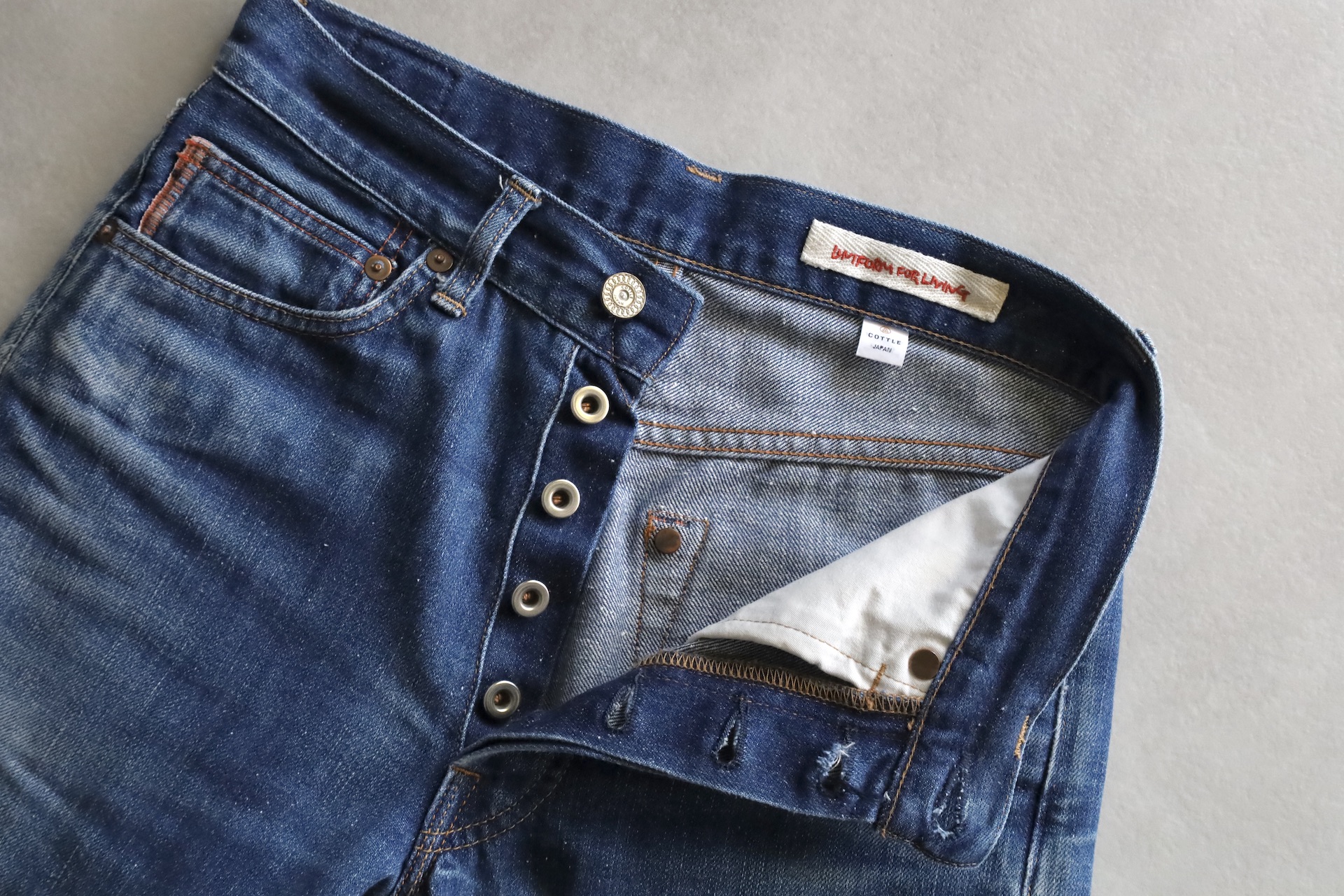
インディゴ染色が施された生地に対して、色と太さが異なる多様な縫製糸を適材適所に使い分けることで、強度はもちろん、コントラストが利いた色合いは、たくさんの人を潜在的に魅了し続けるものだと思います。
また、その上、銅製リベットや、ボタンフライなど、他の服とは異なる複数のメタルパーツをも駆使した構成。
これもまた、それぞれの資材だけではなく、それを取り付けるための専用ミシンが必要となる。
このような古き良きディテールも、もしかしたら、今後の洋服産業においては次第に省かれていってしまうものかもしれません。
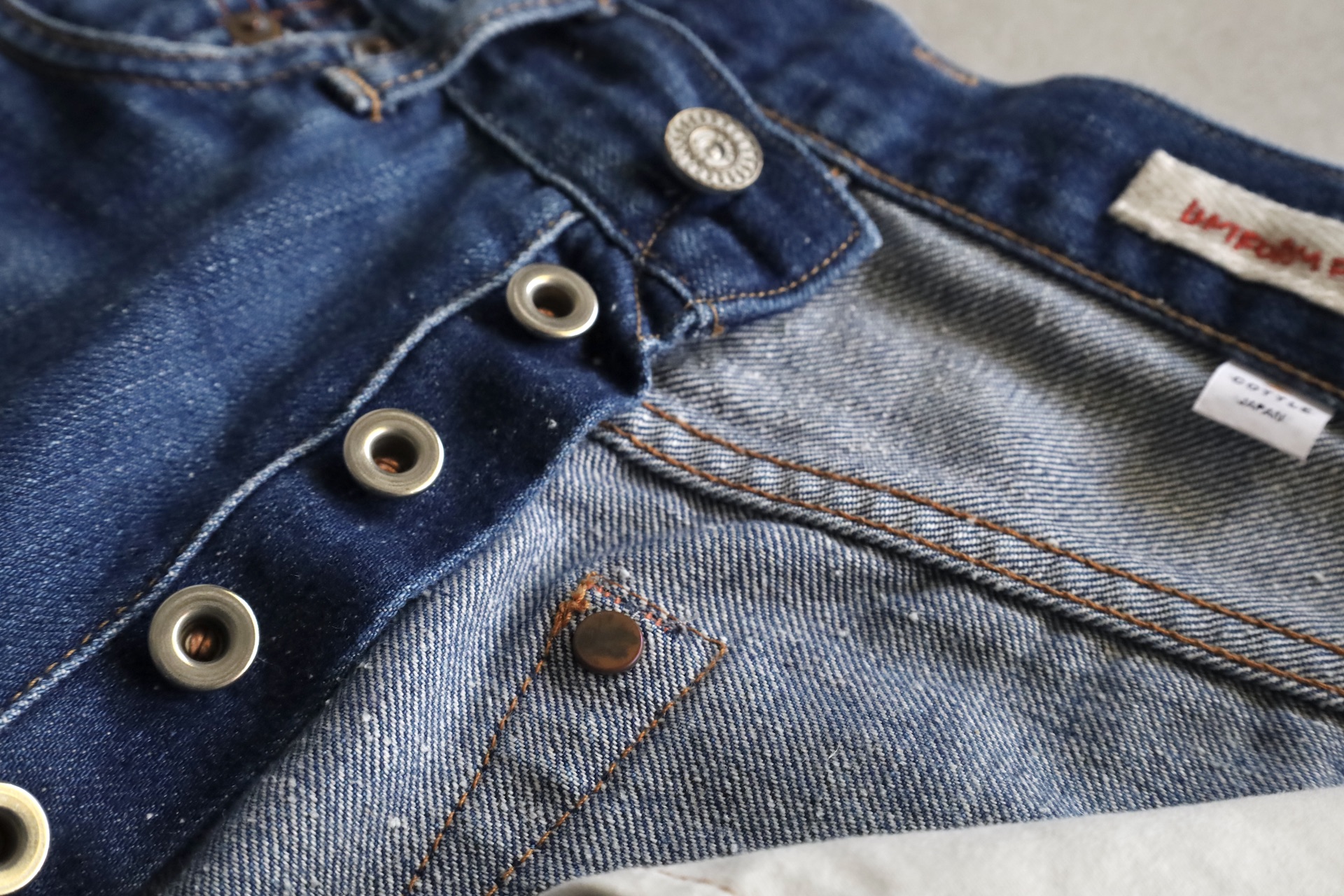
更に、COTTLEのC.T.L STRAIGHT DENIM PANTSにも搭載されているオーセンティックなディテールをいくつか。
まず、ウエストベルトを身頃に取り付けるための二種類の縫製仕様。
ウエスト帯の上部は本縫いで、そこから延長して、フロントのVステッチに繋がる。
身頃とウエストベルトの取り付けは、環縫い(チェーンステッチ)。
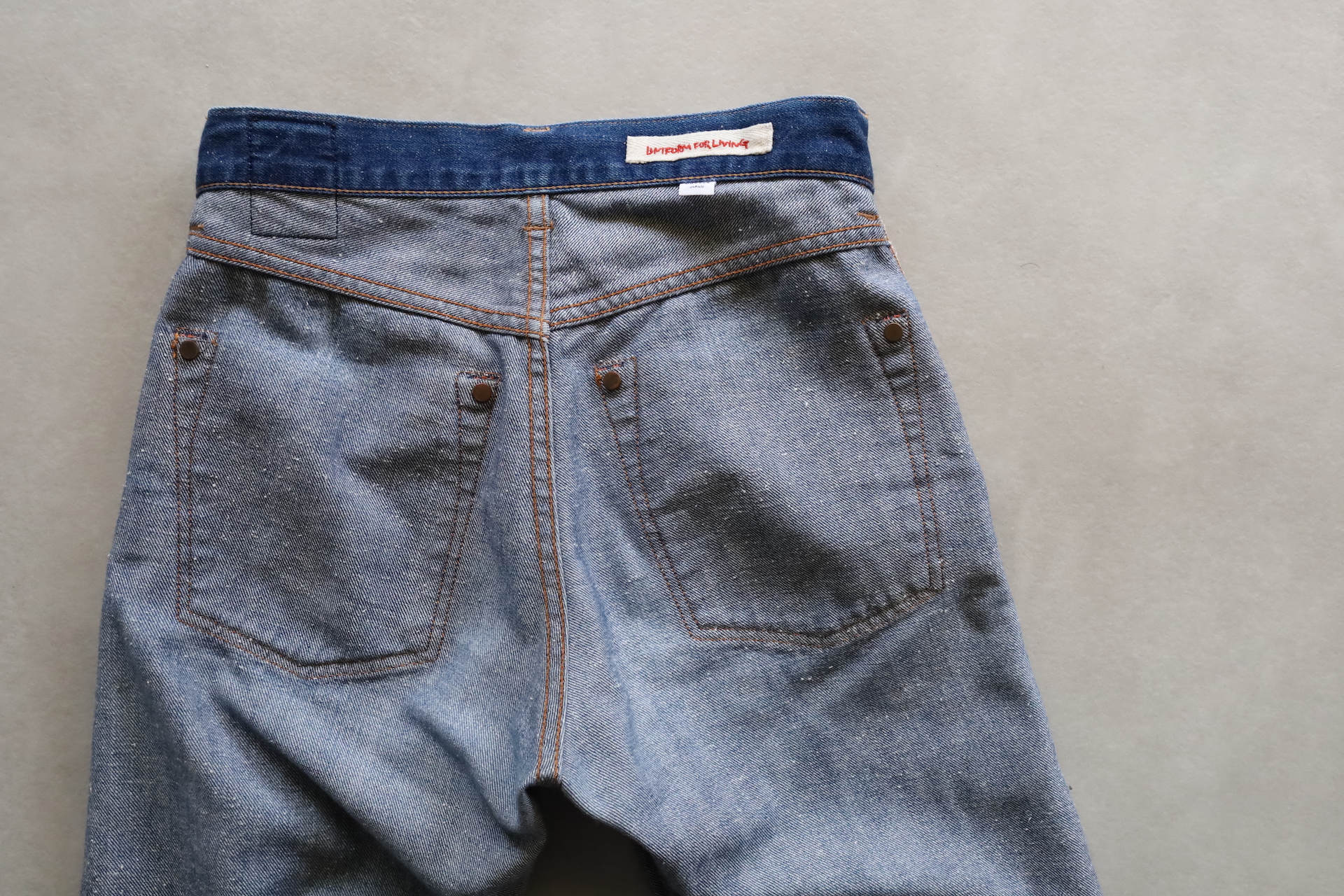
隠しカンドメ、リベット。
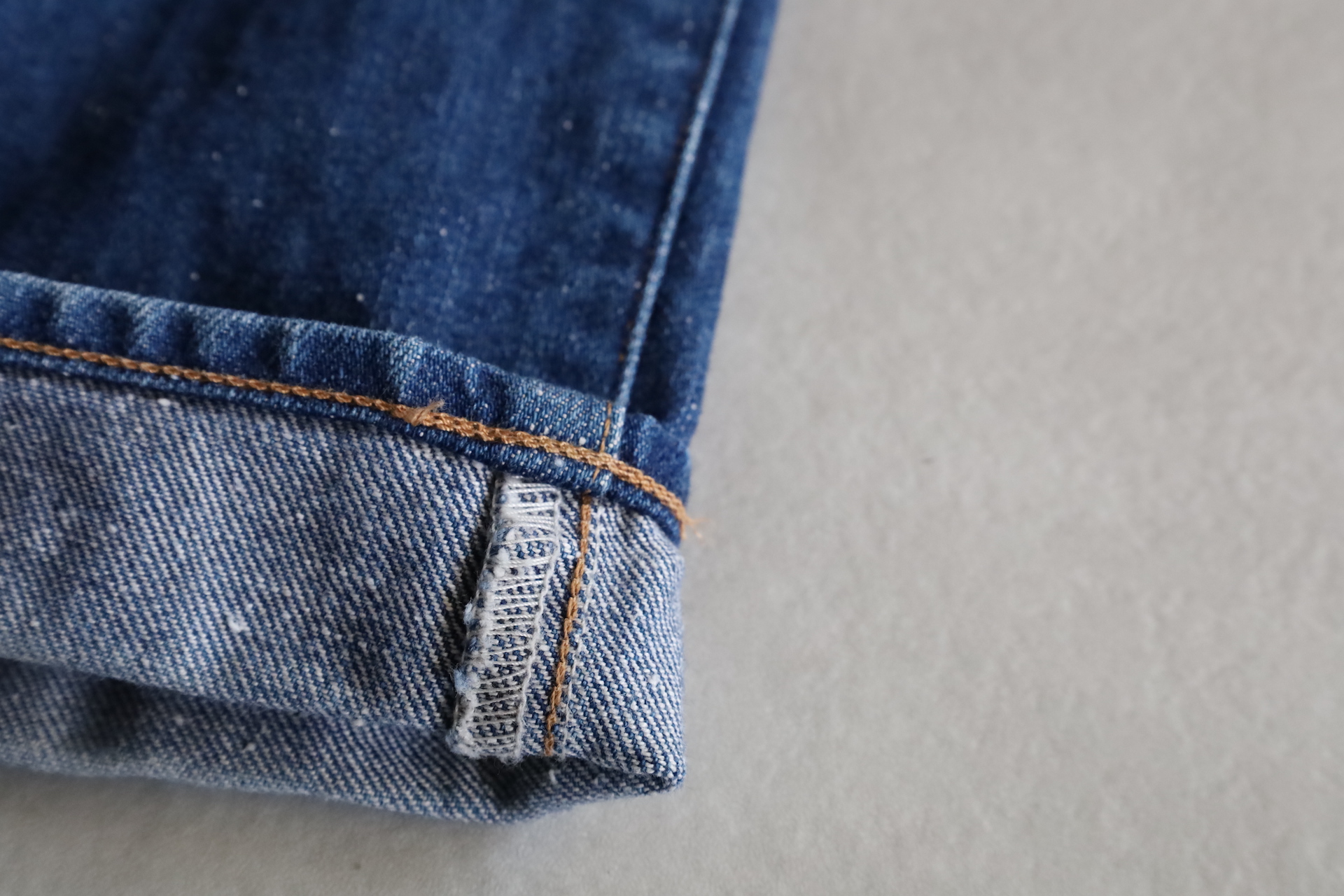
こちらは、インシームの箇所。
ジーンズ特有のもので、この箇所は、大股と言います。
オーバーロックによる生地端の処理+身頃の接ぎ合わせが同時にできる”インターロック”という縫製。
この箇所についても、今ではほとんどの場合は1色の糸のみが使用されるのではないかと思いますが、COTTLEでは2色の糸が使い分けられています。
加えて、裾は、10mm幅の三つ折りで、生地端から8mmの位置にチェーンステッチが入る。
このステッチのmm数もオーセンティックなルールをマークしていますし、そのチェーンステッチは着用時に見えにくい内股からぐるりと一周し、内股で縫い終わる。
返し縫いができないチェーンステッチの特徴として、縫い始めと終わりの箇所が露出する場合には、ほつれ防止のために縫い重ねることが必要ですが、そのステッチの重なりを外から見えにくい内股側で仕上げるというもの。
これに関しては、リーバイスでも他のブランドでも、内股側、もしくは外側など見たことがありますが、COTTLEでは着用時に綺麗に見える内股側で仕上げる配慮を行なっています。
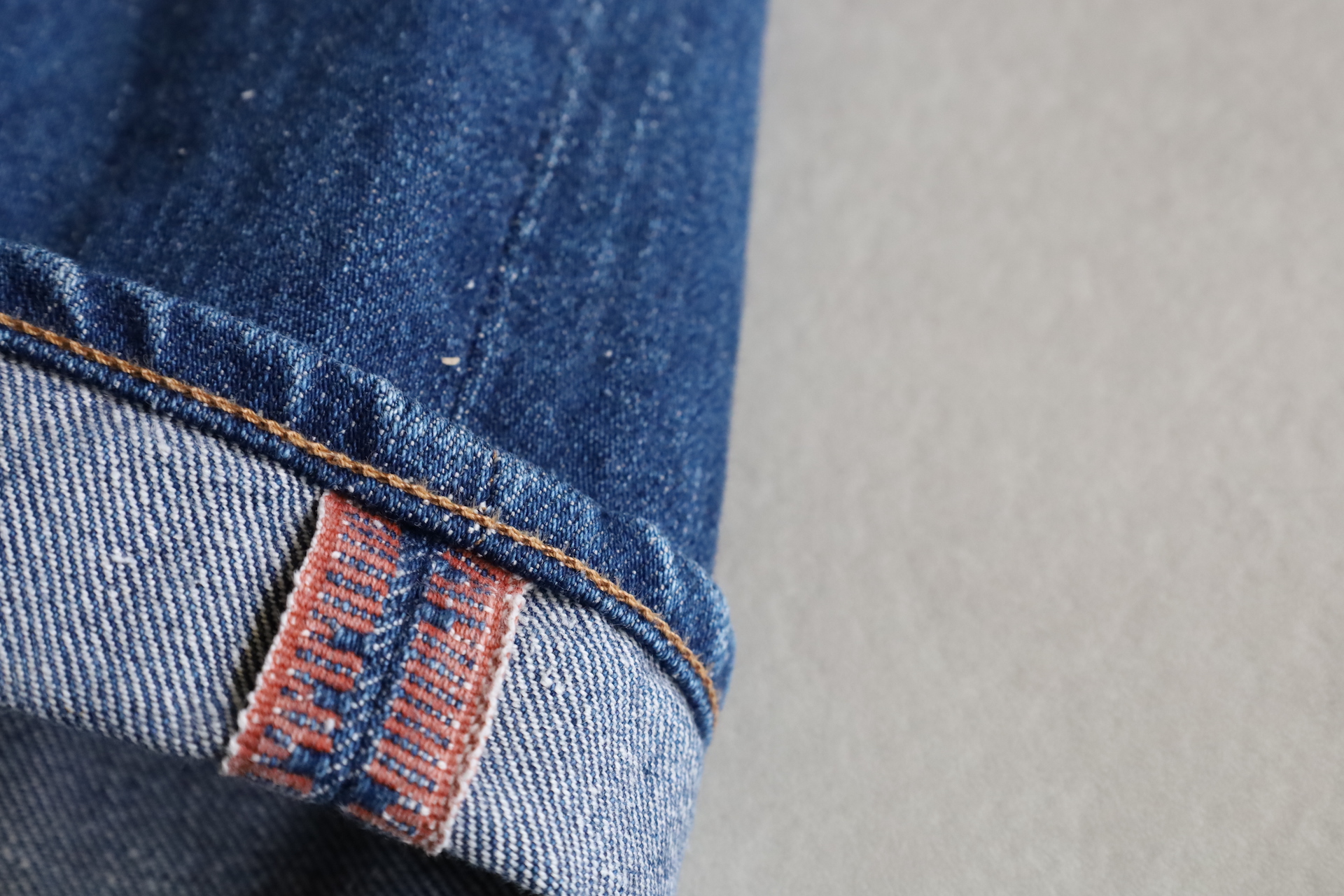
そして、こちらはアウトシーム側。
アウトシームは、セルヴィッチの割り仕様。
3年半着用していると、8mm幅のチェーンから生まれる捻れたシームパッカリングと、生地そのもののフェード、加えてブランドでつくり上げた”ベンガラ染めセルヴィッチ”のコントラストがとても綺麗なものだと思います。
ブランドオフィシャルページのDictionaryにこの”ベンガラ染めセルヴィッチ”については、記載がありますので、そちらをご覧ください。
すごいですよ。
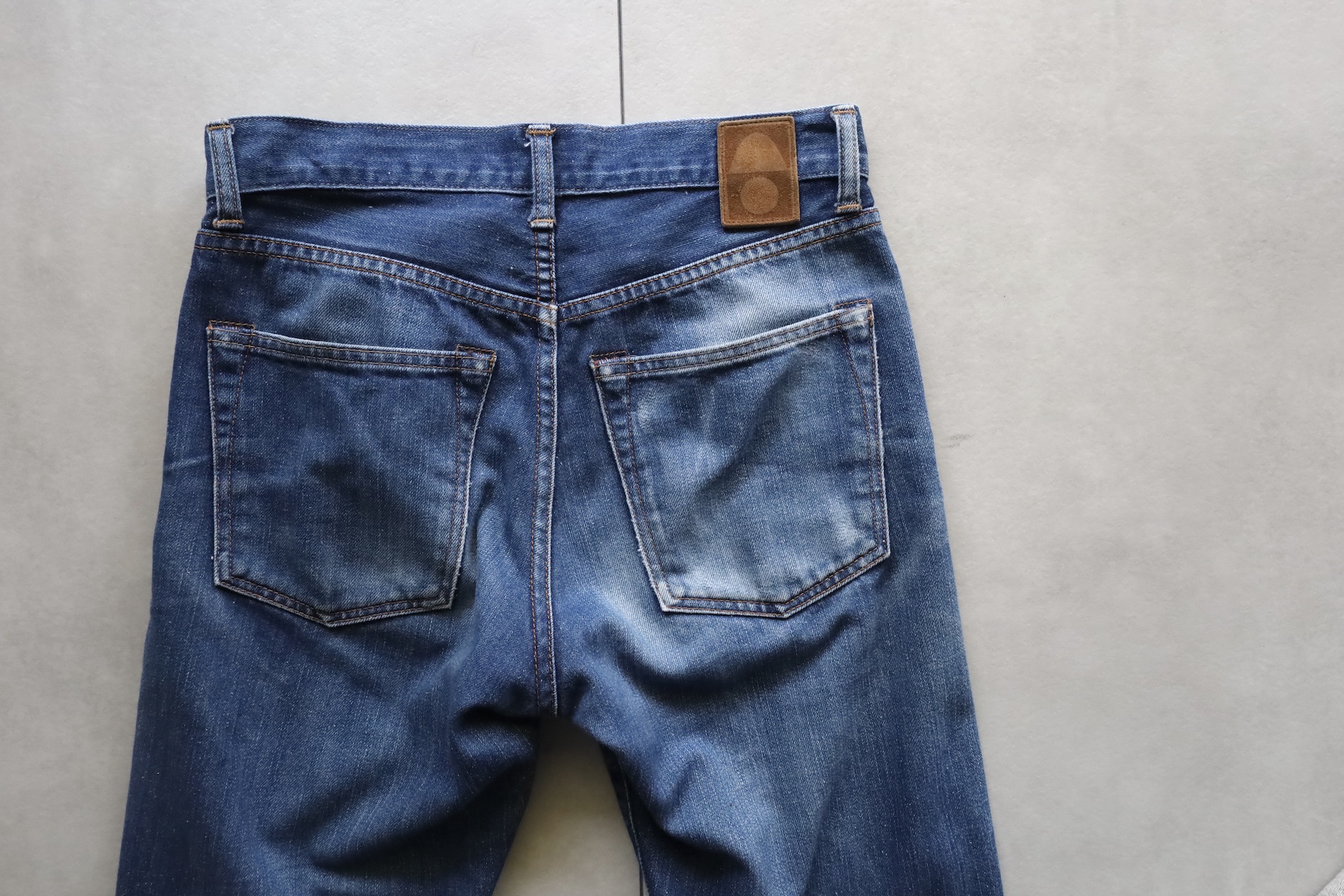
何よりもオーセンティックなジーンズで特徴なのは、”後ろ姿”だと思います。
後ろ姿こそ、ジーンズを象徴する箇所であり、他のパンツでは形にならず、それが”オーセンティックなジーンズの美しさ”に繋がっているのではないかと僕は考えています。
その要因は、主に3つ。
まず1つ目は、後身頃は、ウエスト帯付け以外、全ての縫製箇所でダブルステッチが施されること。
次に2つ目は、全てのパンツの中で、唯一ジーンズにしか存在しないディテールである”バックヨーク”という三角形状のパーツ。
これはワークウェアとして大量に生産を行なうために、直線で合理的な生地の裁断をするためのジーンズですが、お尻から腰にかけての丸みに沿わせるために考えられたディテール。
他の種類のパンツ場合、この部分にはバックヨークではなく、腰からダーツが入ることになります。
そして、そのバックヨークを左右それぞれの後身頃と”巻き縫い”によって接ぎ合わせられます。

表から見ると本縫いが二本並行して入るように見え、裏から見るとそれがチェーンステッチ。
生地を縫い合わせると同時に、生地端が縫い代の中に入り込み、生地端の処理が不要となる特徴的な縫製方法です。
更に、この後身頃には、ジーンズ特有の規則というものがあります。
それが3つ目、バックヨークと身頃の”地の目の方向”と、巻き縫い縫製の特性による”身頃の高さ関係”。
地の目については、身頃は縦地の目・バックヨークは横地の目となります。
生地幅の狭いセルヴィッチ生地の取り都合というものもあったと思いますが、そうすることでバックヨークがしなやかに伸び、腰へフィットすることにもつながると思いますが、褪色していくデニムが地の目が変わることで色合いのコントラストが生まれます。
また、巻き縫いについては、縫う方向が定まっているため、背中心から”左側が上、右側が下になる”という縫製の特性があります。
以下がCOTTLEのデザイナーがバックヨークと身頃の巻き縫いをする際の写真です。
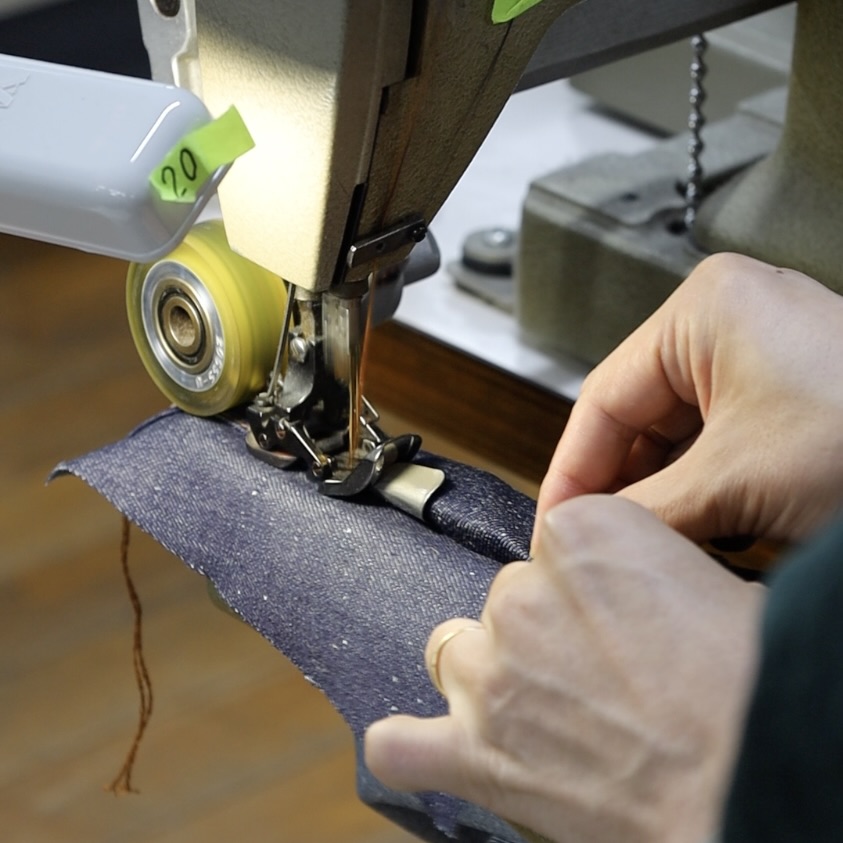
右手に持つ生地が内側に折り返され、右側の生地が上になっています。
巻き縫いには、このような特徴があります。
多くの場合、パンツは尻グリの縫製は、縫い代が割り縫いになることがほとんどだと思います。
そのため、ジーンズのように完成後に身頃の高低差が生まれるということは、ほとんどないのではないでしょうか。
以下に簡単な画像を掲載していますので、ご覧ください。
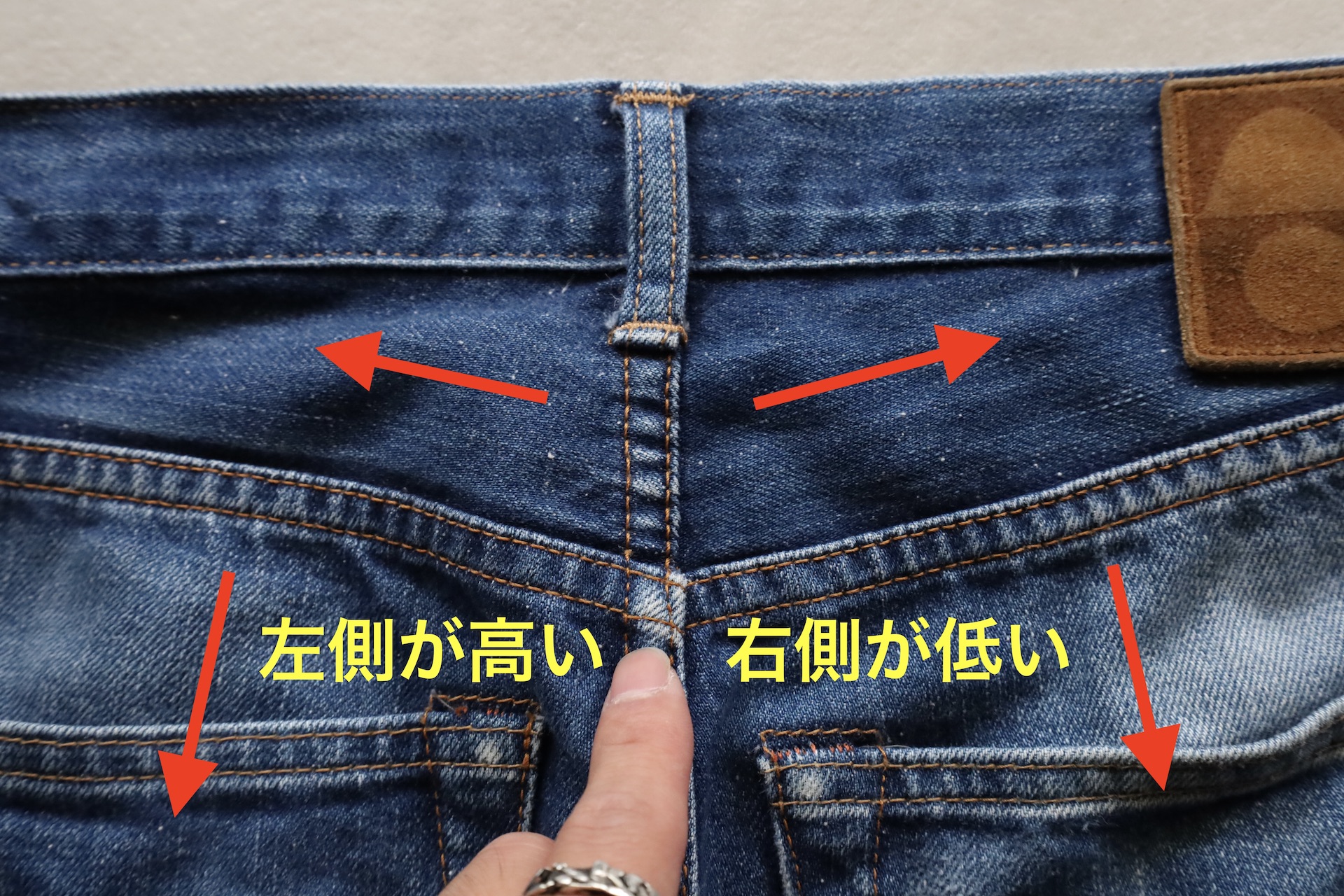
赤い矢印が地の目を表しています。
黄色い文字が、指先の背中心の接ぎから、左右の高さの違いを記載しているものです。
このようにジーンズの後身頃には、複数の規則が存在し、それぞれが作用し合うからこそ、見た目のコントラストが生まれ、それが何十年もの間、人々の心を惹きつけているのではないかと僕は考えています。
COTTLEのC.T.L STRAIGHT DENIM PANTSを見ていると、改めてオーセンティックなジーンズというものの良さを再確認できることや、それだけではない現代に生きるつくり手が向き合って製作したものの魅力を感じます。
しかしながら、”オーセンティックなジーンズ”という分野においては、”色が落ちてこそ”その見た目は、カッコいいものになると言われます。
反対に、新品でインディゴの色合いが濃いものは、野暮ったいとまで言われることがあると思います。
色が落ちるまでは我慢であり、穿き込んでいかに早く色を落とすかということに注力されている方々も見受けられる。
僕も、20代前半はヴィンテージレプリカデニムのジャンルに身を置いていたこともあり、自分自身がそうでした。
しかし、COTTLEのジーンズは、新品のものでも野暮ったいどころか、特有の魅力を感じてきました。
その理由は、生地の色合い、ネップなどのクオリティもそうですが、僕自身はそれだけではなく、ジーンズそのもののパターンワークや、先ほどまで紹介してきた縫製のレベルの高さにあると思っています。
他のジーンズと比べ、穿いた瞬間から「全然違う」と感じられるのがCOTTLEのもの。
これこそが、僕自身がCOTTLEのC.T.L STRAIGHT DENIM PANTSの特別感として思っている冒頭に記載した以下の2つ。
“”1つ目は、先に記載したようにオーセンティックな5ポケットジーンズのディテールの範囲内でつくり上げていること。
2つ目は、そこにCOTTLEの明確なオリジナリティが注がれていること。
その2つの要素が非常に高いレベルで合致していることを感じています。””
この2つ目、COTTLEの明確なオリジナリティが注がれていること。によるものだと思います。
これまで紹介をしてきた縫製仕様については、ヴィンテージレプリカを中心とした凝ったジーンズを製作する”デニム工場”では、同様の仕様は行われていることもあります。
しかし、それはあくまでも”デニム専業の工場”であるということがほとんどです。
COTTLEの場合には、デニム製品だけではなく、LEAF VEIN、EARTH WALL、SAKIORI、GOLDEN WHEAT FIELD CORDUROY、SAND BEACHなど様々な生地のコレクションが存在し、その全てが自社縫製工場であるアトリエ内で縫い上げられます。
つまり、アメカジだけではないブランドのジーンズであるということ。
このニュアンスは、とても重要なことだと思います。
例えば、LEAF VEINのZEN JACKETを縫える工場が、C.T.L DENIMを縫うということは、ほとんどありません。逆も同様です。
COTTLEのジーンズを見ていると、”パーツがただ取り付けられた”というものではなく、それぞれの”ディテールが自立している”ように感じます。
誰が縫ってもこのようになるものではなく、”縫製の妙”と言えます。
縫製は技術職でもあり、技術職ということは、どこでどのような工場が縫うのかということで差が生まれるものだと思います。
だから、ジーンズ量産工場で流れ作業的に縫われるのではなく、自社のアトリエ内で、他のCOTTLEのコレクションと同様に縫い進められるということは、とても付加価値があることだと感じています。
具体的に一つ例を挙げると、先ほどから言及している”後ろ姿”。
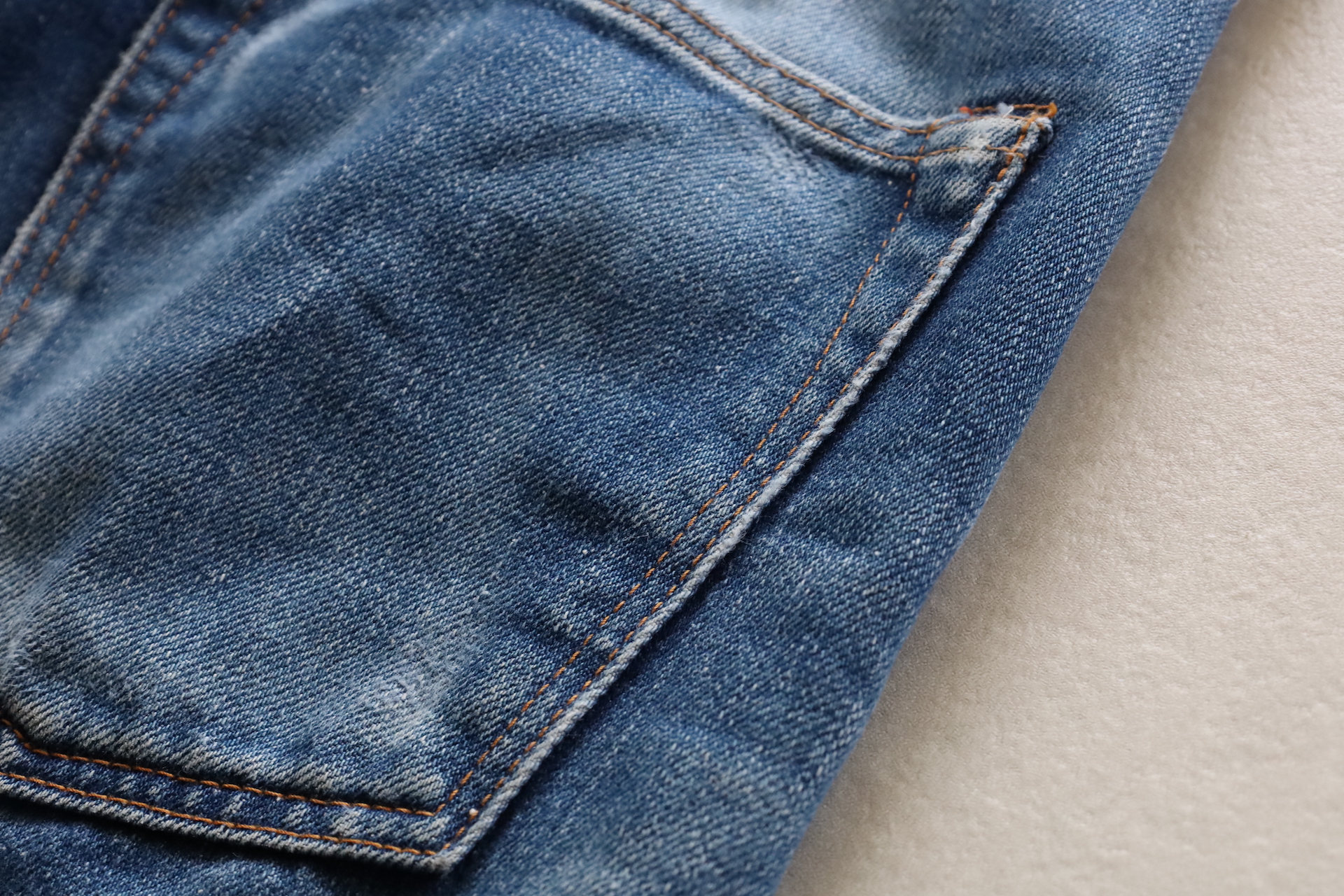
後身頃のバックポケット口は、隠しカンドメ・リベットの仕様となるため、その箇所のみダブルステッチの幅が広くなる必要があります。
ポケット全体は、幅が狭い直線的なダブルステッチにも関わらず、ポケット口に向かうにつれて、滑らかにカーブしてステッチの幅が広がります。

後身頃の他の部分のステッチワークは、ダブルステッチが全て並行で真っ直ぐなのにも関わらず、ポケット口付近のみがカーブしたステッチワーク。
全体が直線で構成されるものの中に、一部のみがカーブすることで、見え方に変化が生まれます。
これは、本当に小さな違いですが、スピーディーに量産をしていく製造現場では行き届かない仕様であり、COTTLEの繊細な設計が感じられる一つだと思います。
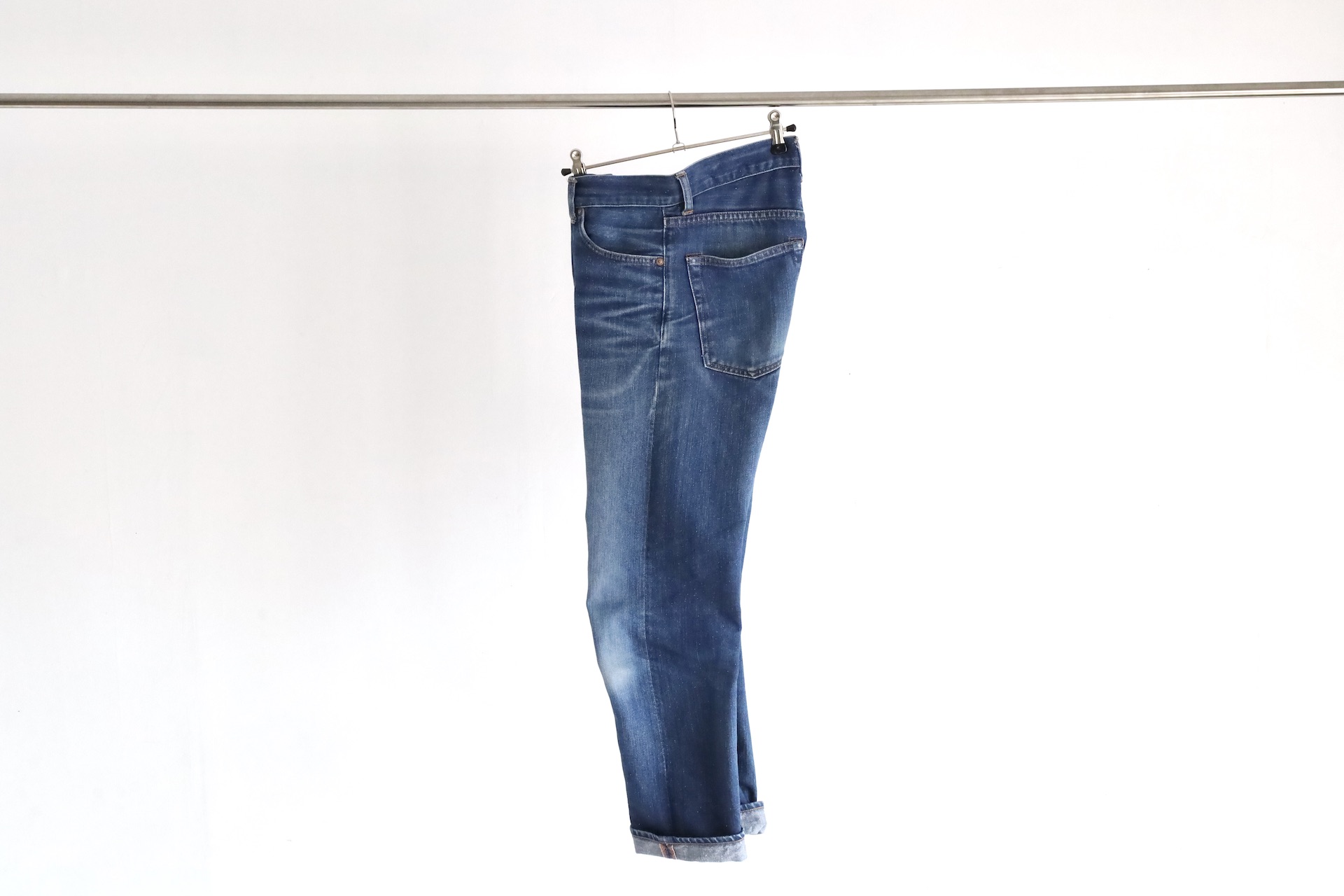
そして、COTTLEのC.T.L STRAIGHT DENIM PANTSは、着用時のアウトラインがとてもオリジナリティがある。
これは、まだ自分のものになっていない時の試着段階からすぐに感じられたものでした。
写真では、よく穿いているので僕自身の形が付いていますが、そのパターンワークには大きな違いがあります。
それが尻グリのラインです。
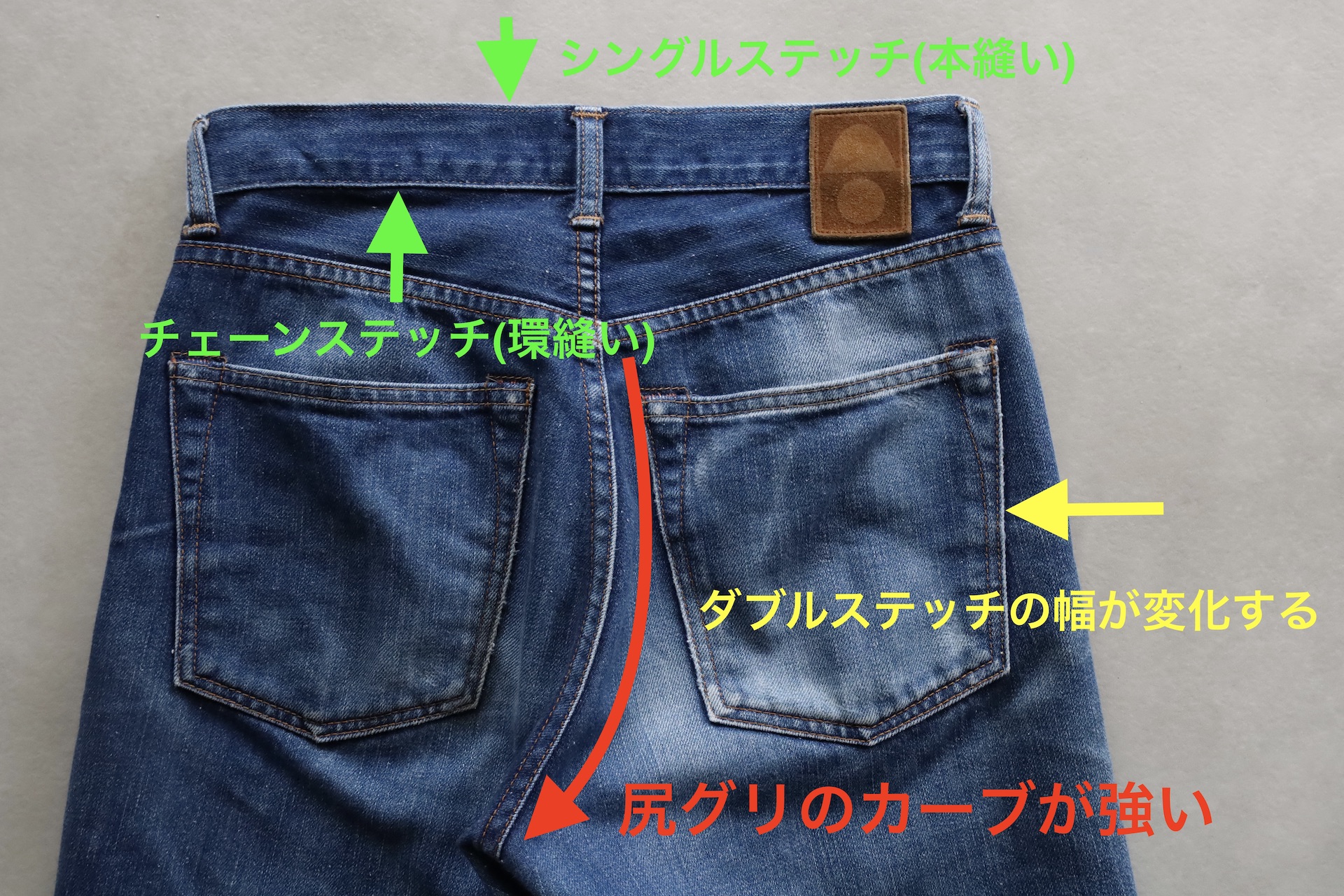
上の写真では、これまでに記載したことも画像に表示していますが、赤い色で示したカーブ。
このお尻のカーブが強く、穿いてすぐにヒップのフィットの心地良さを感じます。
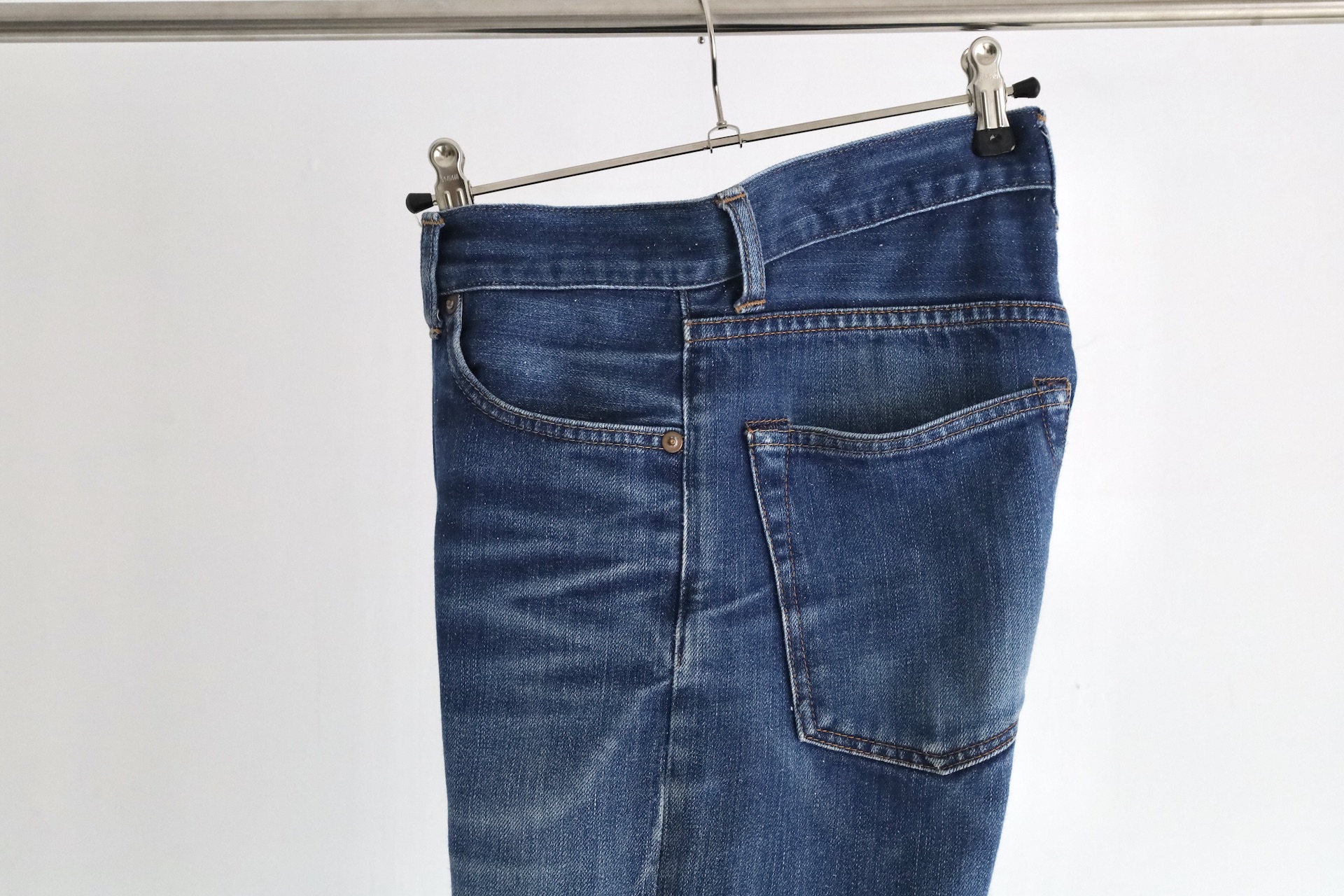
また、こちらの写真を見た際に、ウエストベルトの前後に大きな高低差があるのがご覧いただけると思います。
尻グリのラインや丸みの強さ、後身頃が高い設計。
お尻や腰まわりが後ろから包み込まれるような感覚になり、この着用感はとても気持ち良いものです。
そして、日々穿いていて無理がないことも感じています。
ジーンズというものは、イメージでは固くゴワゴワするような印象もありますが、COTTLEは、どちらかと言うと気持ちの面ではスウェットパンツを穿くような感覚と似ているかもしれません。
それだけ無理なく、心地良く穿けるもの。
だから、日々使いたくなる特徴がある。
これは、ブランドとして大事に考えているもので、”民藝”の考え方に通ずるように思います。
日々の暮らしの中で使うためのものとして生まれたものが民藝品。
ついつい手が伸びてしまうような洋服だなと実感しています。
あと、見た目においては、足が長く見えるように感じるし、見事なアウトラインが出てくれ、多くの方に綺麗なシルエットであることを体感してもらえると思います。


そして、最後に生地について。
ジーンズで明確なオリジナリティを生み出そうと思うと、避けて通ることができないのが”生地開発”。
歴史があり、現行でも無数に存在する生地であるからこそ、差別化を図るには”生地開発”ということは必要になりますが、通常のコレクションブランドでは、ここまでのクオリティのオリジナル生地の開発は極めて難しいと思います。
このshop talkでは、ブランドのオフィシャル情報とは別の内容を掲載することを考えているため、生地の詳細については先述の通り、ブランドのDictionaryをご覧いただきたいと思っていますが、コットン100%ではなく、コットン91%とリネン9%という他に例のない混率。
この混率は、取り組みから3年以上の歳月をかけて形にしたものだと言います。
非常に特徴的な柔らかい肌馴染みと、着用者の動作への自然な追従、手紡ぎのような風合いのネップ、そして、”デニムの聖地”と呼ばれるようになった児島地域で、最初にジーンズを製作した人々への敬意を表した鮮やかなブルーの色合い。
更には、”民藝の街”と言われる倉敷市で生まれ育ったデザイナーが”倉敷本染手織研究所”で出会った藍染とベンガラ染めの手織りタペストリーからきっかけを得たベンガラ染めセルヴィッチ。
このセルヴィッチの図柄も非常に特徴的で、それを実現させるため、糸が日本の様々な産地を飛び回ってベンガラ染めとなり、シャトル織機にセルヴィッチの部分のみ別の織機を取り付けて織り上げられるもの。
オーセンティックという枠組みの中でありながらも、その製作プロセスは、普通の考え方では及ばないものであり、時に狂気と思えるほどにまで拘るCOTTLEならでは生地開発だと思います。
このように”オーセンティック”なルールに則った中で、様々な面でこれだけのオリジナリティを生み出しているのは、どのブランドでもできることではなく、素晴らしいことだと感じています。
だから、僕は数あるジーンズの中でも、COTTLEのC.T.L STRAIGHT DENIM PANTSが好きで日々使っています。
LE BERGER / Herd Limited.
shop talk & communications by Akihiko Fukuda
__________
The English translation is provided below:
This time, I would like to write about COTTLE’s denim.
On the brand’s official website, there is a detailed description of the denim products under the section called Dictionary.
Please take a look from the link below:
COTTLE Official Page “Dictionary”
In this shop talk, I would like to share my personal thoughts and feelings through a pair that I wear regularly—the “C.T.L STRAIGHT DENIM PANTS.”

The jeans in this photograph are the ones I have worn very often over a period of roughly three and a half years.
COTTLE has its atelier in Kojima, Kurashiki City, Okayama Prefecture—an area known as the “sacred land of jeans.”
Throughout his career, the designer has also produced numerous denim products.
In Kojima, where the brand is based, countless denim garments have been made every day, both in the past and in the present.
As mentioned earlier, the designer, Mr. Watanabe, also has a background of having created many pieces over the years.
When producing denim as COTTLE, amid the countless pairs of jeans that already exist in the world, he continuously asked himself:
What kind of jeans would be truly worth creating?
After much thought and experimentation, what ultimately emerged was the C.T.L STRAIGHT DENIM PANTS.
Rather than denying the past, the brand pays deep respect to its predecessors.
Within the framework of the “authentic five-pocket jeans,” something new was born.
This is what I find so compelling—and why I continue to wear them so often.
If I were to divide the reasons I’m drawn to the C.T.L STRAIGHT DENIM PANTS into two main points, they would be these:
- As mentioned earlier, they are made within the scope of details belonging to authentic five-pocket jeans.
- Within that framework, they are infused with COTTLE’s unmistakable originality.
I feel that these two elements coexist and harmonize at an exceptionally high level.


The pair I have been wearing started from the WASHED INDIGO state — one-washed and gas-dried.
Since I am small in stature, I wear size 0, the smallest available size.

When it comes to one-wash or rigid denim, I personally prefer to wear a size that fits my waist perfectly—so that I don’t need a belt.
For me, if I can fasten the top button when trying them on, that’s the right size.
Because of that, as you can see in the photos, there are marks left on the waistband where the fabric has been pulled when I sit down, and what are commonly called “agari-hige” (upward whiskers) formed from wearing a tightly fitted size.
Here, I would like to introduce the first of the two points I mentioned earlier—
that these jeans are made within the scope of the details of authentic five-pocket jeans.

The term “authentic” generally refers to a standard that traces back to the LEVI’S 501XX, released in 1947.
Even just around the waistband area of those jeans, there are numerous distinctive details that set them apart from other types of pants, and those that follow these particular rules are what we call authentic five-pocket jeans.
Let me share a few examples of how COTTLE’s jeans adhere to that lineage.
First, the color and thickness of the sewing threads vary depending on the section being stitched.
COTTLE uses as many as eight different kinds of thread to produce a single pair of jeans.
Among all types of garments, jeans are exceptionally unique in this respect—no other clothing item changes thread color and count so deliberately by location.
To produce denim garments, a wide range of specialized sewing machines are required: lockstitch machines, overlock machines, interlock machines, chain-stitch machines, felling machines, belt-loop machines, bartack machines, buttonhole machines, tack-button and rivet attaching machines, and many more.
Normally, clothing is sewn using threads that match or closely resemble the color of the fabric.
Denim fabric, which originated in France, took root and evolved into jeans as a form of clothing in California, USA.
It is said that if jeans had been born in New York instead, the stitching would likely have been the same color as the fabric, and this double-stitch, contrast-colored thread—now iconic—might never have come into being.
There’s something a little romantic about that thought.
In manufacturing, changing the thread color or type depending on the section adds extra cost.
Even at Levi’s, over time, the use of multiple thread colors was discontinued.
Today, among the many brands still making jeans, I believe very few use as many different threads as COTTLE does.

By skillfully using sewing threads of different colors and thicknesses in the most suitable places across the indigo-dyed fabric, these jeans achieve not only strength but also a contrast of tones that, I believe, continues to captivate people on a subconscious level.
In addition, their construction makes use of multiple metal parts that are unlike those found in other garments—such as copper rivets and a button fly.
Each of these components requires not only its own specific material but also specialized machines for attachment.
Details like these—born of an older, more time-honored approach—may, perhaps, gradually disappear from the clothing industry in the years to come.

Furthermore, several authentic details are also incorporated into COTTLE’s C.T.L STRAIGHT DENIM PANTS.
First, there are two different stitching constructions used to attach the waistband to the body.
The upper part of the waistband is sewn with a lockstitch, which continues and connects into the front V-stitch.
The joining of the body and the waistband, on the other hand, is done with a chain stitch (kan-nui).

Hidden bartacks and rivets.

This part is the inseam area.
It is unique to jeans and is called the ō-mata in Japanese.
Here, the sewing method used is called interlock stitching, which simultaneously overlocks the fabric edge and joins the body panels together.
Even in this section—which in most modern jeans would likely be sewn using only a single thread color—COTTLE intentionally uses two different threads.
In addition, the hem is finished with a triple fold 10 mm wide, and a chain stitch runs 8 mm from the fabric edge.
These specific millimeter measurements also mark one of the authentic rules, and the chain stitch runs all the way around the hem, beginning and ending at the inseam, where it remains less visible when worn.
Since chain stitches cannot be back-stitched, when the starting and ending points are exposed, they must be overlapped to prevent fraying.
COTTLE finishes this overlap neatly on the inseam side—where it is least noticeable from the outside.
I’ve seen this done on the inseam or sometimes on the outer seam by Levi’s and other brands, but COTTLE deliberately finishes it on the inseam so that the jeans look cleaner when worn.

And this is the outer seam side.
The outseam is finished with a pressed-open selvedge construction.
After wearing them for three and a half years, I find the twisted seam puckering created by the 8 mm-wide chain stitch, together with the natural fading of the fabric and the contrast of the brand’s original bengara-dyed selvedge, to be truly beautiful.
For more details about this bengara-dyed selvedge, please refer to the brand’s official Dictionary page.
It’s truly remarkable.

Above all, what I believe most characterizes authentic jeans is the back view.
The back view is the very element that symbolizes jeans.
It’s something that cannot be replicated in other types of pants—and I think that’s precisely what gives authentic jeans their beauty.
There are three main reasons for this.
First, except for where the waistband is attached, every seam on the back body is finished with double stitching.
Second, among all kinds of pants, only jeans have a unique detail known as the back yoke—a triangular-shaped piece of fabric.
Originally, this feature was developed for workwear, which needed to be produced efficiently through straight-line cutting.
The back yoke was designed to conform to the natural roundness of the body, from the hips up to the waist.
In other types of pants, instead of a back yoke, darts are typically added from the waist to create that shaping.
And the back yoke of jeans is joined to the left and right back panels through rolled seams (also called flat-felled seams).

From the outside, this seam appears as two parallel lines of lockstitching, while on the inside, it forms a chain stitch.
This sewing method is distinctive in that it joins the fabric pieces while enclosing the raw edges within the seam allowance, eliminating the need for separate edge finishing.
Furthermore, the back body has a set of rules unique to jeans.
The third of these is the relationship between the grain direction of the back yoke and the body, and the difference in panel height that results from the nature of the rolled seam (flat-felled seam) construction.
As for the grain direction: the main body is cut on the vertical grain, while the back yoke is cut on the horizontal.
This may have originally been due to the cutting constraints of narrow-width selvedge fabric, but it also allows the back yoke to stretch softly and fit more naturally to the waist.
In addition, as the denim fades over time, the change in grain direction creates a subtle contrast in color tone.
Moreover, because rolled seams must always be sewn in a fixed direction, a characteristic difference in height appears: from the center back seam, the left side sits higher and the right side lower.
Below is a photograph showing COTTLE’s designer sewing the back yoke to the body using this rolled seam technique.

The fabric held in the right hand is folded inward, with the right-side piece positioned on top.
This is one of the defining characteristics of a rolled seam.
In most types of pants, the crotch seam is usually constructed with a split seam.
Because of that, it’s quite rare for a garment to develop the kind of height difference in the body panels that appears in jeans after completion.
Below, I’ve included a simple image for reference. Please take a look.

The red arrows indicate the direction of the fabric grain.
The yellow text shows the difference in height between the left and right sides from the point where the back panels are joined at the center seam.
In this way, the back body of jeans follows multiple structural rules, and it is precisely because these rules interact with one another that visual contrast is created — a quality that, I believe, has continued to fascinate people for decades.
When I look at COTTLE’s C.T.L STRAIGHT DENIM PANTS, I’m reminded once again of the beauty of authentic jeans, and at the same time, I feel the unique appeal of something made by a creator living in the present, sincerely facing the act of making.
However, in the realm of authentic jeans, it is often said that only once the color has faded do they truly begin to look cool.
Conversely, new jeans with a deep indigo hue are sometimes even regarded as awkward or unfashionable.
Before the color fades, one must endure — and some people devote their efforts to wearing them as much as possible in order to achieve faster fading.
I myself was like that once, when I was in my early twenties and deeply immersed in the world of vintage replica denim.
But COTTLE’s jeans — far from being awkward when new — have always felt uniquely attractive to me, even in their unworn, deep-blue state.
Of course, part of that comes from the color of the fabric and the quality of the neps, but for me, it goes beyond that.
I believe the difference lies in the pattern work of the jeans themselves and in the extremely high level of sewing craftsmanship I’ve described earlier.
Compared to other jeans, from the very moment you put them on, you can feel that COTTLE’s are entirely different.
This, to me, is precisely what defines the special character of the C.T.L STRAIGHT DENIM PANTS, as expressed in the two points I mentioned at the beginning:
“First, that they are made within the scope of the details of authentic five-pocket jeans.
Second, that they are infused with COTTLE’s clear and unmistakable originality.
I feel that these two elements come together and coexist at an exceptionally high level.”
It is this second point — the infusion of COTTLE’s distinct originality — that I believe defines them.
The sewing specifications I’ve described so far can, at times, also be found in jeans made by denim factories that specialize in creating complex vintage-replica pieces.
However, those are, for the most part, factories dedicated exclusively to denim.
COTTLE, on the other hand, does not produce only denim.
It has collections in a wide variety of fabrics — LEAF VEIN, EARTH WALL, SAKIORI, GOLDEN WHEAT FIELD CORDUROY, SAND BEACH, and more — all of which are sewn entirely within its own atelier.
In other words, these are jeans that do not belong solely to the “American casual” lineage.
I think this nuance is extremely important.
For instance, it would be almost unheard of for a factory that sews the LEAF VEIN ZEN JACKET to also produce the C.T.L DENIM — and the reverse is equally true.
When I look at COTTLE’s jeans, I feel that the parts are not merely attached components; rather, each detail seems to stand on its own.
This is not something that would result no matter who sews them — it’s what could be called the subtle mastery of sewing.
Sewing is a technical craft, and as with any craft, the outcome inevitably differs depending on where and how the garment is sewn.
That’s why, instead of being made in a mass-production denim factory on an assembly line, the fact that these jeans are sewn within the brand’s own atelier — alongside the rest of COTTLE’s collections — adds a tremendous layer of value.
To give one concrete example, let’s return to the back view I mentioned earlier.

Because the back pocket opening on the rear body uses a hidden bartack and rivet construction, the double-stitch width must be widened only in that specific area.
Although the rest of the pocket is sewn with narrow, straight double stitching, the stitch lines gently curve and broaden toward the pocket opening.

While the double stitching on all other parts of the back body runs perfectly straight and parallel, only the area near the pocket opening features curved stitching.
Within an overall structure composed entirely of straight lines, this single curved section introduces a subtle variation in appearance.
It’s a truly small difference, yet one that could never be achieved in a fast-paced, mass-production environment.
I see it as one of the details that conveys the delicate precision of COTTLE’s design.

And the C.T.L STRAIGHT DENIM PANTS by COTTLE have a truly original outline when worn.
I could sense this immediately—even at the stage of simply trying them on, before they had become my own.
In the photos, they now bear the shape of my body from frequent wear, but the pattern work itself has a significant difference.
That difference lies in the line of the back rise.
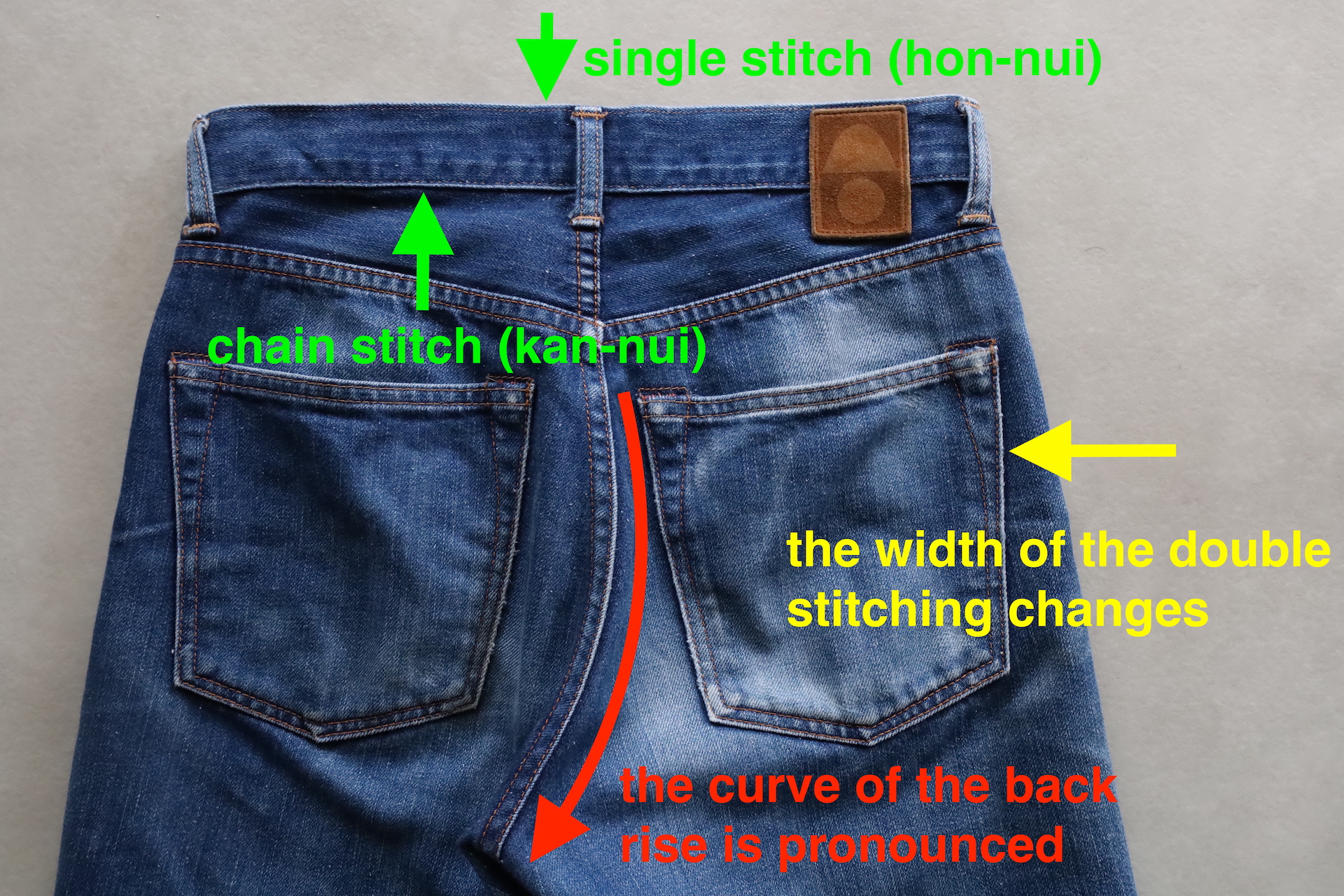
In the photo above, you can also see what I’ve described so far—the curve shown in red.
This curve around the hips is quite pronounced, and the moment I put the jeans on, I can feel how comfortably they fit around the seat.

In this photo as well, you can see that there is a noticeable height difference between the front and back of the waistband.
The curvature and strength of the back rise, along with the higher position of the back body, create a sense that the hips and waist are gently wrapped from behind—and this feeling when wearing them is truly pleasant.
I also feel that they are comfortable to wear on a daily basis, without any strain.
Jeans are often imagined as being stiff and rough, but COTTLE’s jeans, in terms of how they feel, are perhaps closer to the sensation of wearing sweatpants.
They are that effortless and comfortable to wear.
That’s why you naturally want to reach for them every day.
I think this quality connects deeply with what the brand values—it reminds me of the philosophy of mingei (folk craft).
Objects born to be used in everyday life—that’s what defines folk craft.
And I truly feel that these jeans are the kind of clothing you instinctively reach for.
In terms of appearance, too, they make the legs look longer and create a beautifully defined outline—something I believe many people will be able to experience for themselves.


And finally, about the fabric itself.
When it comes to creating true originality in jeans, fabric development is something that cannot be avoided.
Because denim has such a long history and already exists in countless variations, differentiation requires the creation of an original fabric.
However, for most fashion brands, developing an original fabric of this level of quality would be extremely difficult.
In this shop talk, I aim to present content that differs from the brand’s official information, so as mentioned earlier, for detailed fabric specifications, please refer to the brand’s Dictionary.
But to summarize briefly—the fabric is not 100% cotton; it’s an unprecedented blend of 91% cotton and 9% linen.
I’ve been told that this blend took more than three years of effort to bring to completion.
The result is a fabric with an exceptionally soft texture against the skin, a natural flexibility that follows the wearer’s movements, and neps with a hand-spun feel.
Its vivid shade of blue pays homage to the early pioneers of denim production in Kojima—the “sacred land of jeans.”
Furthermore, the bengara-dyed selvedge was inspired by a handwoven tapestry of indigo and bengara dye that the designer—born and raised in Kurashiki, known as “the city of mingei (folk craft)”—encountered at the Kurashiki Honzome Teori Kenkyujo (Kurashiki Hand-Dye and Weaving Laboratory).
The selvedge pattern itself is also highly distinctive.
To realize it, the yarn travels across various regions of Japan for bengara dyeing, and a shuttle loom is modified by attaching a separate loom only for the selvedge portion during weaving.
Although the jeans remain within the framework of what’s considered authentic, their production process goes far beyond ordinary thinking.
It reflects a level of dedication so intense that it could even be called a kind of beautiful madness—a fabric development process that is uniquely COTTLE’s own.
To generate this degree of originality while still adhering to the rules of authenticity is something very few brands could ever achieve.
I find it truly remarkable.
That is why, among the countless jeans out there, I love COTTLE’s C.T.L STRAIGHT DENIM PANTS and wear them every day.
